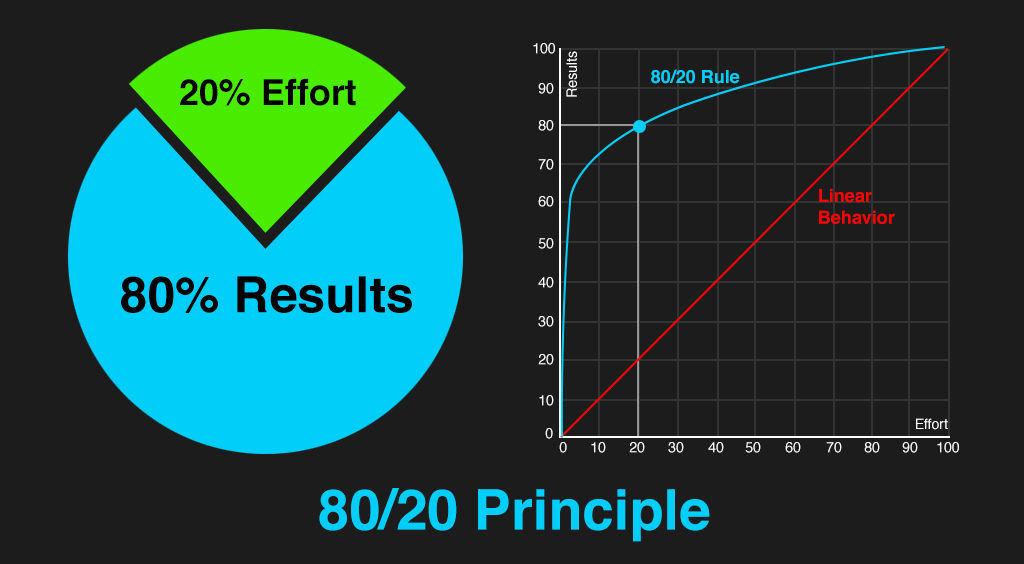Pareto Principle has originally taken from Italian economist Vilfredo Pareto and he created a mathematical formula to describe the unequal distribution of wealth in his country in 1906. Pareto observed that twenty percent of the people owned eighty percent of the wealth. In the late 1940s, quality guru, Dr. Joseph M. Juran, attributed the 80/20 Rule to Pareto, calling it Pareto’s Principle. Pareto’s Principle or Pareto’s Law is a useful tool to help prioritize and manage the work and it can work well as for business application.
In general, the Pareto Principle is the observation (not law) that most things in life are not distributed evenly. It can mean all of the following things:
- 20% of the customers create 80% of the revenue
- 20% of the input creates 80% of the result
- 20% of the bugs cause 80% of the crashes
- 20% of the workers produce 80% of the result
- And on and so on…
In order to use this idea, the careful approach needs to be taken. Firstly, it needs to clarify the numbers 20 and 80 must add to 100, and this is not always the case.
In reality, 20% of the workers could generate 10%, 50%, 80%, or 99%, or even 100% of the result. Think about it, in the case of a group of 100 workers, 20 could do all the work while the other 80 not working. In that case, 20% of the workers did 100% of the work. Thus, we require bearing in mind that the 80/20 rule is a rough guide about typical distributions.
It also needs to recognize that the numbers don’t have to be “20%” and “80%” precisely. The key point is that most things in life (effort, reward, and output) are not distributed evenly – some even contribute more than others.
The key point is that each unit of work (or time) doesn’t contribute the same amount.
In an ideal world, if every employee would contribute the same amount, every bug would be equally significant; every feature would be equally loved by users, then planning would be so easy. However, in reality, and in the real world that isn’t always the case.

www.interaction-design.org
The 80/20 rule observes that most things have an unequal distribution. Out of 5 things, perhaps 1 will be a good thing. That good thing/idea/person will result in a majority of the impact of the group (the blue line). We’d like life to be like the red line, where every piece contributes equally, but that doesn’t always happen in the real life.
This ratio can change for sure, it could be 80/20, 90/10, or 90/20 because remember, the numbers don’t have to add to 100. The key point is that most things are not 1/1, where each unit of “input” (effort, time, labor) contributes exactly the same amount of output.
So Why is This Useful?
The Pareto Principle helps to understand that the greater part of results come from a minority of inputs. By realizing this, the possible applications are as follows.
- 20% of workers contribute 80% of results, so focus on rewarding these employees.
- 20% of bugs contribute 80% of crashes, so focus on fixing these bugs first.
- 20% of customers contribute 80% of revenue, so focus on satisfying these customers.
- The examples go on.
The point is to realize that often focusing on effort on the 20% that makes a difference, instead of the 80% that doesn’t add much.
In economics terms, there is a diminishing marginal benefit. This is related to the law of diminishing returns: each additional hour of effort, each extra worker is adding less “oomph” to the final result. By the end, you are spending lots of time on the minor details.
The point of Pareto Principle is to put in the amount of effort needed to get the most benefits of money or investment. It’s usually in the first 20% (or 10%, the exact amount can vary). In the planning stage, it may be better to get 5 fast prototypes rather than 1 polished product.
In conclusion, the point of the Pareto principle is to recognize that most things in life are not distributed evenly. Make decisions on allocating time, resources and effort based on realizing and focusing the important of 20% and you have the option to do this. In addition to that, Pareto Principle is not meant only do 80% of the work needed. It may be true that 80% of a building is built in the first 20% of the time, but you still need the rest of the building in order for it to work. It may be true that 80% of the Mona Lisa was painted in the first 20% of the time, but it wouldn’t be the masterpiece it is without all the details. The Pareto Principle is an observation, not a law of nature.
You require all 100% when you are seeking top quality. When you are trying to optimize your bang for the buck, focusing on the critical 20% is a time-saver. See what activities generate the most results and give them your appropriate attention.






